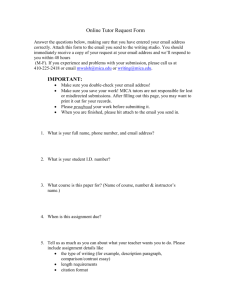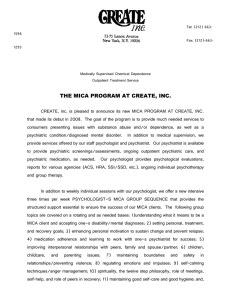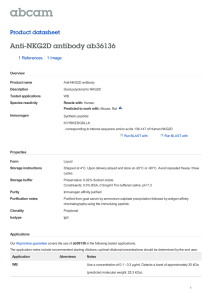Descargar PDF
advertisement
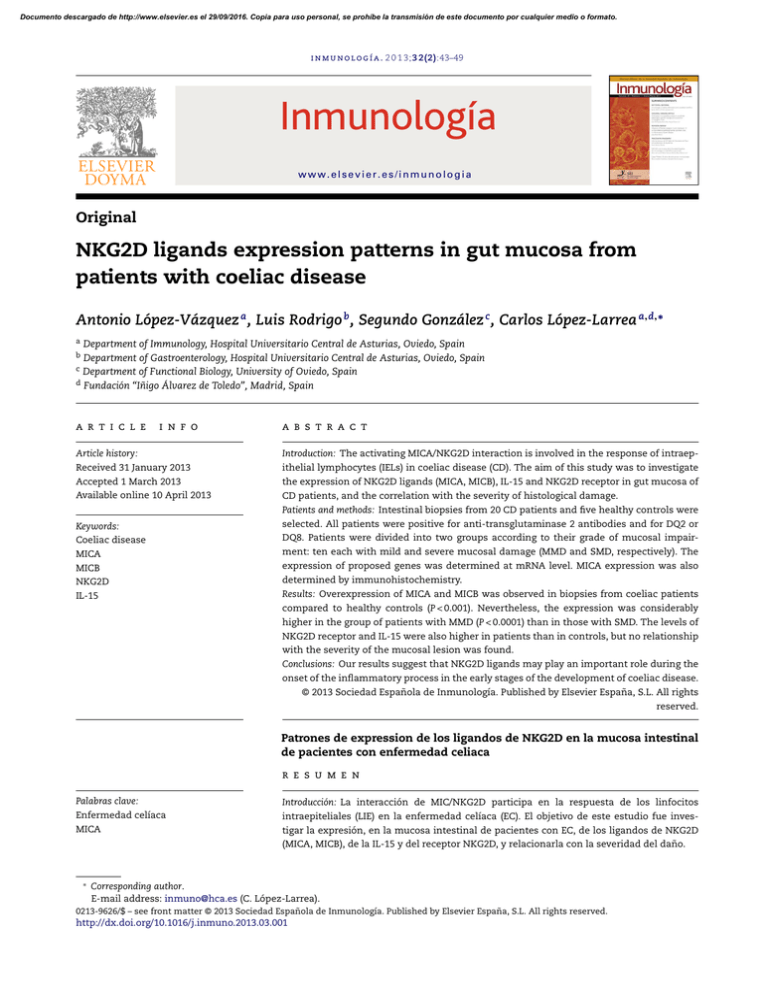
Documento descargado de http://www.elsevier.es el 29/09/2016. Copia para uso personal, se prohíbe la transmisión de este documento por cualquier medio o formato. i n m u n o l o g í a . 2 0 1 3;3 2(2):43–49 Inmunología www.elsevier.es/inmunologia Original NKG2D ligands expression patterns in gut mucosa from patients with coeliac disease Antonio López-Vázquez a , Luis Rodrigo b , Segundo González c , Carlos López-Larrea a,d,∗ a Department of Immunology, Hospital Universitario Central de Asturias, Oviedo, Spain Department of Gastroenterology, Hospital Universitario Central de Asturias, Oviedo, Spain c Department of Functional Biology, University of Oviedo, Spain d Fundación “Iñigo Álvarez de Toledo”, Madrid, Spain b a r t i c l e i n f o a b s t r a c t Article history: Introduction: The activating MICA/NKG2D interaction is involved in the response of intraep- Received 31 January 2013 ithelial lymphocytes (IELs) in coeliac disease (CD). The aim of this study was to investigate Accepted 1 March 2013 the expression of NKG2D ligands (MICA, MICB), IL-15 and NKG2D receptor in gut mucosa of Available online 10 April 2013 CD patients, and the correlation with the severity of histological damage. Patients and methods: Intestinal biopsies from 20 CD patients and five healthy controls were Keywords: selected. All patients were positive for anti-transglutaminase 2 antibodies and for DQ2 or Coeliac disease DQ8. Patients were divided into two groups according to their grade of mucosal impair- MICA ment: ten each with mild and severe mucosal damage (MMD and SMD, respectively). The MICB expression of proposed genes was determined at mRNA level. MICA expression was also NKG2D determined by immunohistochemistry. IL-15 Results: Overexpression of MICA and MICB was observed in biopsies from coeliac patients compared to healthy controls (P < 0.001). Nevertheless, the expression was considerably higher in the group of patients with MMD (P < 0.0001) than in those with SMD. The levels of NKG2D receptor and IL-15 were also higher in patients than in controls, but no relationship with the severity of the mucosal lesion was found. Conclusions: Our results suggest that NKG2D ligands may play an important role during the onset of the inflammatory process in the early stages of the development of coeliac disease. © 2013 Sociedad Española de Inmunología. Published by Elsevier España, S.L. All rights reserved. Patrones de expression de los ligandos de NKG2D en la mucosa intestinal de pacientes con enfermedad celiaca r e s u m e n Palabras clave: Introducción: La interacción de MIC/NKG2D participa en la respuesta de los linfocitos Enfermedad celíaca intraepiteliales (LIE) en la enfermedad celíaca (EC). El objetivo de este estudio fue inves- MICA tigar la expresión, en la mucosa intestinal de pacientes con EC, de los ligandos de NKG2D (MICA, MICB), de la IL-15 y del receptor NKG2D, y relacionarla con la severidad del daño. ∗ Corresponding author. E-mail address: inmuno@hca.es (C. López-Larrea). 0213-9626/$ – see front matter © 2013 Sociedad Española de Inmunología. Published by Elsevier España, S.L. All rights reserved. http://dx.doi.org/10.1016/j.inmuno.2013.03.001 Documento descargado de http://www.elsevier.es el 29/09/2016. Copia para uso personal, se prohíbe la transmisión de este documento por cualquier medio o formato. 44 i n m u n o l o g í a . 2 0 1 3;3 2(2):43–49 Seleccionamos biopsias intestinales de 20 pacientes con EC y de MICB Pacientes y métodos: NKG2D cinco controles sanos. Todos los pacientes resultaron positivos para anticuerpos anti- IL-15 transglutaminasa 2 y para HLA-DQ2 o HLA-DQ8. Los pacientes fueron divididos en dos grupos según el grado de deterioro de la mucosa: diez con daño leve y otros 10 con daño grave (denominados MMD y SMD, respectivamente). En todos ellos se analizó la expresión de MICA, MICB, NKG2D y IL-15 a nivel de ARN mensajero, y en el caso de MICA se completó el estudio analizando su expresión por inmunohistoquímica. Resultados: Se observó sobreexpresión de MICA y MICB en biopsias de pacientes celíacos en relación con los controles sanos (p < 0.001). Sin embargo, la expresión fue notablemente mayor en el grupo de pacientes MMD que en aquellos del grupo SMD (p < 0.001). Los niveles de receptor NKG2D y IL-15 también fueron mayores en pacientes que en controles, pero no se encontró relación con la gravedad de la lesión de la mucosa. Conclusiones: Nuestros resultados sugieren que los ligandos de NKG2D pueden desempeñar un papel importante durante el inicio del proceso inflamatorio en las primeras etapas del desarrollo de la enfermedad celíaca. © 2013 Sociedad Española de Inmunología. Publicado por Elsevier España, S.L. Todos los derechos reservados. Introduction For a long time coeliac disease was thought to be a relatively rare pathology that only appeared in childhood. Now, however, it is recognized as being a very common disease that can be diagnosed at any age.1,2 Among the most typical characteristics of the disease are a strong genetic association with the HLA alleles DQ2 and DQ8 and its onset being precipitated by an environmental factor, namely, gluten.3 Gliadin, the alcoholsoluble fraction of the protein, has been identified as the cause of this intolerance, but the great majority of gluten proteins are also probably toxic in coeliac disease.4,5 These proteins induce an inflammatory process in the intestine, although the process regresses when they are removed from the diet, thereby restoring the proper structure and function of the mucosa.6 The intraepithelial infiltration by lymphocytes is the first stage in the pathogenic process of CD. In the epithelium of an exposed coeliac patient, the populations of CD8+ T cells and ␥␦+ T cells become more numerous, and both express markers of cellular proliferation and activation. When treatment with a gluten-free diet is instigated, the number of CD8+ lymphocytes returns to normality, whereas intraepithelial lymphocytes (IELs) ␥␦+ remain permanently increased. The role of such populations is one of the main unresolved matters in the pathogenesis of the CD.7 MHC class I chain-related molecules A and B (MICA and MICB) are homologous with classical HLA-class I but have no role in antigen presentation.8 These are cell surface glycoproteins that are mainly expressed in endothelial, epithelial cells, fibroblasts and activated monocytes. MICA expression is induced by stress situations and is upregulated in infection and tumour transformation. This protein is a ligand for the NKG2D-activating receptor, which is mainly expressed in Natural Killer (NK) and CD8+ T cells. In NK cells, the interaction between MICA and NKG2D induces the cytolytic capacity of these cells, while in CD8+ it acts as a costimulatory signal that complements antigen recognition by T cell receptor (TCR).9 MICA and MICB are both polymorphic, and some variants are associated with coeliac disease. The transmembrane variant MICA 5.1, equivalent to the MICA 008 allele, is associated with atypical forms of CD10 independently of the presence of HLA-DQ2.11 Additionally, the MICB allele 0106 is also overrepresented in patients with atypical forms of CD.12 These ligands are largely unexpressed in most healthy tissues. However, aberrant expression of NKG2DL has been detected in some autoimmune diseases, for example in the prediabetic pancreas islet of NOD mice13 and the synoviocytes of rheumatoid arthritis patients.14 Furthermore, MICA is constitutively expressed at low levels in normal intestinal epithelial cells (IECs). MIC is induced at very high levels on the surface and in the crypts of the small bowel of CD patients.15 It has also been reported that the gliadin-derived peptide 31–49 upregulates MICA expression in epithelial cells as a consequence of IL-15 induction.16 Another study has demonstrated the direct involvement of the MICA-NKG2D interaction in the activation of intraepithelial lymphocytes in response to the direct toxic effect of gluten.17 This activation damages the enterocytes, and could be the initial event that ultimately leads to villous atrophy. The aim of this study was to investigate the expression of MICA, MICB, NKG2D and IL-15 by RT-PCR and immunochemistry in biopsies of patients with active CD, and to evaluate the association with the severity of the lesion. Materials and methods Patients The levels expression of NKG2D, IL-15, MICA and MICB were measured in biopsies from 20 patients diagnosed with coeliac disease. All biopsies were obtained from at least three different sites in the proximal-to-distal duodenum, yielding 72 samples in total. All biopsies were obtained before a gluten-free diet was initiated (Table 1). To ensure a homogeneous group of samples, the patients selected for this study had the same lesion type in all the biopsies collected. Five samples from individuals with no digestive pathology were used as healthy controls. Biopsies from patients were divided into two groups on the basis of the MARSH classification: those with minimal or mild Documento descargado de http://www.elsevier.es el 29/09/2016. Copia para uso personal, se prohíbe la transmisión de este documento por cualquier medio o formato. 45 i n m u n o l o g í a . 2 0 1 3;3 2(2):43–49 Table 1 – Clinical and genetic features of coeliac patients and healthy controls. Slight to mild mucosal damage n = 10 Age (Mean ± SD) Anti-TG2 HLA-DQ2 HLA-DQ8 Digestive symptoms Extradigestive symptoms Anaemia Dermatitis herpetiformis Other 17 ± 13 10 (100%) 9 (90%) 1 (10%) 6 (60%) 11 ± 10 10 (100%) 10 (100%) 2 (20%) 9 (90%) 9 (90%) 1 (10%) 3 (30%) 10 (100%) – 2 (20%) mucosal damage (Marsh I, II and IIIa; MMD) and those with severe mucosal damage (Marsh IIIb and IIIc; SMD). Additionally, all patients and controls were typed for HLA-DQ using the PROTRANS Domino System HLA Celiac Disease kit (PROTRANS GmbH, Ketsch, Germany). All patients and controls gave informed consent and the study was approved by ethics committee of our Hospital. Real-time RT-PCR Total RNA was derived from tissue samples using NucleoSpin RNA II from Macherey-Nagel (Düren, Germany) and reversetranscribed using the First Strand cDNA Synthesis kit for RT-PCR (AMV) from Roche Diagnostics, GmbH (Mannheim, Germany), following the manufacturer’s instructions. The resulting cDNA was amplified with specific primer pairs (Table 2) in duplicate (40 cycles: 95 ◦ C for 15 s and 60 ◦ C for 1 min), monitoring the amplification using SYBRGreen chemistry with the ABI PRISM 7000 Sequence Detection System (Applied Biosystems, Weiterstadt, Germany). Primers, listed in Table 2, were selected to flank introns whenever possible. Data were analysed using the CT method for relative quantification. Briefly, threshold cycles (CTs) for GAPDH, MICA-MICB, NKG2D and IL-15 were determined in duplicate. We chose arbitrary values for healthy donor 1 (HD1) as standard values and calculated the relative increase (rI) in copy number in relation to this standard values according to the formula: rI = 2 − [(CT Sample − CT Reference) − (CT Standard Sample − CT Standard Reference)]. Similar amplification efficacy for MICA, MICB, NKG2D, IL-15 and GAPDH was determined by analyzing serial cDNA Table 2 – Real-time PCR primers. Primers Sequence ′ GADPH 5 GADPH 3′ MICA/B 5′ MICA 3′ MICB 3′ NKG2D 5′ NKG2D 3′ IL-15 5′ IL-15 3′ ′ Severe mucosal damage n = 10 5 -CGG AGT CAA CGG ATT TGG TC-3′ 5′ -ATTCATATTGGAACATGTAAACCATGTAG-3′ 5′ -CACCTGCTACATGGAACACAGC-3′ 5′ -TATGGAAAGTCTGTCCGTTGACTCT-3′ 5′ -ACATGGAATGTCTGCCAATGATC-3′ 5′ -GAGGTCTCGACACAGCTGG-3′ 5′ -GCAGCAGAAAAAAAATGGAGATG-3′ 5′ -CGGCTACCACATCCAAGGAA-3′ 5′ -GCTGGAATTACCGCGGCT-3′ Healthy controls n=5 16 ± 12 – 1 (20%) 0 – – – – dilutions with values of the slope of the log of the amount of cDNA compared with a CT of <0.1. Amplicons were examined on 3% agarose gels to ensure they were of the correct size. Immunohistochemistry A polyclonal serum against the ␣2 domain of the MICA molecule was generated by immunising rabbits with a synthetic peptide of the 140–160 (MNVRNFLKEDAMKTKTHYHAM) translated sequence of MICA, as described previously.18 This serum, known as s8p, was purified on an AFFI-T gel affinity column (KE-MEN-TEC, Copenhagen, Denmark), following the manufacturer’s instructions, and then tested in parallel with a negative control of preimmune rabbit serum. For immunohistochemistry staining, 5-m-thick sections of small gut biopsies from paraffin blocks were cut and mounted on polylysine-coated slides. Deparaffinised samples were blocked with 10% normal human serum in PBS for 30 min at room temperature to eliminate non-specific bindings. Sections were incubated with polyclonal serum anti-MICA s8p, for 1 h at room temperature in a humid chamber. Antibody binding was detected using the peroxidase EnVision System (Dako, CA, USA). In negative controls, the primary antibody was omitted or replaced by a preimmune rabbit serum at the same dilution. Statistical analysis Univariate analyses were used to describe the characteristics of the study sample. Student’s t test was used to compare differences between the means of continuous variables, statistical significance being concluded for values of p < 0.05. Results The primary aim of our study was to analyse the expression of MICA in biopsies of patients diagnosed with CD by real-time PCR. First, patients clearly showed increased expression levels than healthy controls (mean value 4.96 vs. 0.16; p < 0.001). When we analysed data from CD patients with mild mucosal damage, we found higher mean levels of MICA than those with severe damage (9.04 vs. 0.34; p < 0.001). MMD group had increased expression level of MICA mRNA comparing healthy controls (56 times greater; 9.04 vs. 0.16; p < 0.0001) (Fig. 1A). Similarly, the level of expression of MICB was also higher in the same group of biopsies. The average value in MMD patients was 3.22 while the biopsies of SMD patients had a mean value Documento descargado de http://www.elsevier.es el 29/09/2016. Copia para uso personal, se prohíbe la transmisión de este documento por cualquier medio o formato. 46 i n m u n o l o g í a . 2 0 1 3;3 2(2):43–49 A B 14.00 10.00 5.00 p<0.001 p<0.0001 mRNA expression mRNA expression 12.00 p<0.001 8.00 6.00 4.00 4.00 p<0.01 MMD 3.00 SMD Healthy controls 2.00 1.00 2.00 0.00 p=NS 0.00 MICA C MICB D 0.50 2.00 p<0.05 p<0.05 0.40 p=NS 0.30 0.20 0.10 mRNA expression mRNA expression p<0.05 0.00 p<0.05 1.60 p=NS 1.20 MMD SMD 0.80 Healthy controls 0.40 0.00 NKG2D IL-15 Fig. 1 – Levels of mRNA of MICA, MICB, NKG2D and IL-15 in gut mucosa of CD patients and healthy controls. Footnote: Expression of MICA (A), MICB (B), NKG2D (C) and IL-15 (D) by RT-PCR in biopsies of celiac patients and healthy controls. (MMD: Mild mucosal damage; SMD: Severe Mucosal Damage). of 0.14 (p < 0.001). This implies that the expression level of MICB is 27 times that of samples obtained from CD patients with early-stage lesions. We also found that the expression of MICB was 46 times that in MMD (3.22 vs. 0.07; p < 0.01) and only 2 times that in the SMD group (0.14 vs. 0.07; p = NS) compared with healthy control group in both cases (Fig. 1B). Nevertheless, in the case of NKG2D, the mean level of expression in the MMD group of biopsies was slightly lower than that of the SMD patients (0.17 vs. 0.34; p = NS), although the mean level of expression of this receptor was clearly stronger in both groups of patients than in healthy controls (0.003; p < 0.05) (Fig. 1C). These results could reflect the greater number of lymphocytes expressing NKG2D, which infiltrate the mucosa in CD patients, but it is nevertheless clear that there were no associations with the degree of damage. Although IL-15 is known to be a poorly secreted cytokine, we were able to measure mRNA levels by RT-PCR from CD patients (Fig. 1). Both MMD and SMD groups showed similar mean levels of IL-15 expression; these were significantly higher on average than in healthy controls (MMD = 1.20, SMD = 1.19, HC = 0.07; p < 0.05) (Fig. 1D). After analysing the expression of these molecules at the mRNA level, the next step was to identify the MICA protein in biopsies of CD patients. The immunohistochemical analysis of the samples showed a positive epithelial stain in all patients, although there were striking differences in the intensity and pattern of staining between the two groups of samples (Fig. 2). First, biopsies from the MMD group showed an intense expression of MICA that was mainly localised in enterocytes, with apical and intracellular distribution. In samples from the SMD group, less intense MICA staining, mainly distributed in the cytoplasm, was observed. Moreover, there was a positive stain of mononuclear cells within the lamina propia in both groups of samples. Healthy control samples exhibited weak MICA staining in the cytoplasm of the epithelial cells. These results are consistent with the high level of expression of MICA revealed by RT-PCR in samples from patients with mild mucosal damage, and suggest that the expression of this protein may be associated with the initial phases of the lesion. Discussion It has previously been reported that, in coeliac disease (CD), intraepithelial intestinal lymphocytes (IELs) express high levels of NKG2D and expand massively under strong exposure to IL-15 in the epithelial compartment.19 IL-15 is overexpressed in active CD mucosa, where its level is correlated with the degree of tissue damage, as revealed by morphometric analysis, and progressively decreased upon instigation of a gluten-free diet.20 Enterocytes and lamina propia mononuclear (LPM) cells are the main source of this cytokine. IL-15 elicits a series of biochemical changes in the NKG2D signalling pathway, converting cytotoxic T cells (CTL) into lymphocyte activating killer (LAK) cells that contribute to tissue damage in coeliac patients.21 Additionally, the NKG2D ligands MICA and MICB are overexpressed in gut mucosa in response to these immunological changes, in accordance with previous reports.15,17 Our study also confirms that levels of MICA and MICB mRNA are higher in biopsies of CD patients, although, unexpectedly, we found that the levels were inversely correlated with the severity of mucosal damage. Documento descargado de http://www.elsevier.es el 29/09/2016. Copia para uso personal, se prohíbe la transmisión de este documento por cualquier medio o formato. i n m u n o l o g í a . 2 0 1 3;3 2(2):43–49 47 Fig. 2 – Expression of MICA in gut biopsies of CD patients. Footnote: A. MICA high-intensity stain in an intestinal villus from a patient with mild mucosal damage. B. Detailed image of enterocytes with an apical MICA expression pattern. C. Gut mucosa with severe damage. The level of expression of MICA is clearly lower than that in the MMD image. D. Normal gut mucosa. Customarily, intraepithelial infiltration by T CD8+ cells has been considered to be secondary to the activation of T CD4+ cells in the lamina propia because no intraepithelial lymphocytes are restricted by gliadin.7 However, these infiltrates are not present in other intestinal disorders associated with inflammation of the lamina propia, such as Crohn’s disease and other autoimmune enteropathies. This finding suggests that the activation of the CD4+ T cells of the lamina propia does not explain the expansion of intraepithelial lymphocytes in coeliac disease.7 The immune response of the T cells may be directed not only against peptides, but possibly also towards recognising damaged cells that express molecules induced by cellular stress (MIC and HLA-E) and gamma-interferon.6 It has been suggested that these alterations of the intestinal epithelium can occur in coeliac disease. MIC and HLA-E are recognised by the NK cell receptors NKG2D and CD94 present in the intraepithelial lymphocytes and whose expression is strongly induced by IL-15.8,9 Epithelial damage could be caused by the deregulation of this system in the presence of high concentrations of IL-15. The induction of these activating receptors could lead to the uncontrolled activation of the intraepithelial lymphocytes and, ultimately, to villous atrophy.21 In fact, IL15, which enables NKG2D-mediated lymphokine killer activity in CTLs, cooperates with NKG2D to induce cytosolic phospholipase A(2) (cPLA2) activation and arachidonic acid release, which leads to tissue inflammation.22 Our results suggest that the levels of IL-15, determined by RT-PCR, were not closely correlated with the degree of mucosal damage, but were clearly higher than in healthy controls, and were maintained at this high level until the final stages of mucosal impairment. IL-15 may be released by enterocytes as a consequence of proteolytic shedding during the course of CD.23 The blockade of the activity of this cytokine could benefit coeliac patients, as has been demonstrated in animal models.24 In the present study we have analysed the expression of MIC molecules in samples from the mucosa of CD patients with varying degrees of damage. We found the highest levels of MICA and MICB in samples with Marsh I, II and IIIa. The corresponding level of expression was progressively lower in samples with Marsh IIIb and IIIc type lesions. These findings suggest that the increased expression of MIC could be an initial phenomenon related to gluten toxicity and the onset of mucosal damage. In fact, the pathological changes in the enterocytes and the extent of the lesion are inversely correlated with the levels of expression of NKG2D ligands. The increases in the level of expression of MIC molecules on the surface of the enterocytes during the initial stage of coeliac disease make them a target for T␣/CD8+ lymphocytes, which infiltrate the epithelium. The recognition of MICA and MICB by the NKG2D receptor, whose expression is induced by IL-15, acts as a signal for IELs, inducing its activation and leading to damage of enterocytes, thereby causing villous atrophy. The downregulation of MIC expression during the course of mucosal damage may act as a control mechanism for IEL activation, which is involved in the epithelial damage. Additionally, we found that MICA was also expressed in mononuclear cells, which infiltrate the lamina propia. Under these circumstances, the MICA/NKG2D interaction could act as an additional costimulatory signal for NKG2D-positive CD4 T cells. Although we have not analysed the expression of NKG2D in CD4 T lymphocytes, previous studies have shown Documento descargado de http://www.elsevier.es el 29/09/2016. Copia para uso personal, se prohíbe la transmisión de este documento por cualquier medio o formato. 48 i n m u n o l o g í a . 2 0 1 3;3 2(2):43–49 this molecule to be habitually present in these cells in some autoimmune diseases25,26 and in ageing people27 . In conclusion, it is clear that the interaction between NKG2D and MICA/B plays an important role in the pathogenesis of CD, and that this is probably more important in the initial phases of the disease. Blockade of the MIC/NKG2D interaction during the early stages of mucosal injury may prevent the progression of tissue damage and the establishment of clinically significant coeliac disease. 7. 8. 9. 10. Ethical disclosures Protection of human and animal subjects. The authors declare that no experiments were performed on humans or animals for this investigation. Confidentiality of Data. The authors declare that they have followed the protocols of their work centre on the publication of patient data and that all the patients included in the study have received sufficient information and have given their informed consent in writing to participate in that study. Right to privacy and informed consent. The authors have obtained the informed consent of the patients and /or subjects mentioned in the article. The author for correspondence is in possession of this document. 11. 12. 13. 14. 15. Financial disclosure This work was supported by grants from Instituto de Salud “Carlos III” FIS PI08/0566 and PI12/02587, and by “Fondos FEDER” from European Union 16. 17. Conflicts of interest The authors declare no conflict of interest. 18. references 1. Rubio-Tapia A, Ludvigsson JF, Brantner TL, Murray JA, Everhart JE. The prevalence of celiac disease in the United States. Am J Gastroenterol. 2012;107:1538–44, quiz 1537, 1545. 2. Riestra S, Fernandez E, Rodrigo L, Garcia S, Ocio G. Prevalence of coeliac disease in the general population of northern Spain. Strategies of serologic screening. Scand J Gastroenterol. 2000;35:398–402. 3. Marsh MN. Gluten, major histocompatibility complex, and the small intestine. A molecular and immunobiologic approach to the spectrum of gluten sensitivity (‘celiac sprue’). Gastroenterology. 1992;102:330–54. 4. De Re V, Caggiari L, Tabuso M, Cannizzaro R. The versatile role of gliadin peptides in celiac disease. Clin Biochem. 2012, pii: S0009-9120(12)00617-0. 5. Li J, Wang S, Li S, Ge P, Li X, Ma W, et al. Variations and classification of toxic epitopes related to celiac disease among alpha-gliadin genes from four Aegilops genomes. Genome. 2012;55:513–21. 6. Abadie V, Sollid LM, Barreiro LB, Jabri B. Integration of genetic and immunological insights into a model of 19. 20. 21. 22. 23. celiac disease pathogenesis. Annu Rev Immunol. 2011;29:493–525. Sollid LM. Molecular basis of celiac disease. Annu Rev Immunol. 2000;18:53–81. Gonzalez S, Lopez-Soto A, Suarez-Alvarez B, Lopez-Vazquez A, Lopez-Larrea C. NKG2D ligands: key targets of the immune response. Trends Immunol. 2008;29:397–403. Lopez-Larrea C, Suarez-Alvarez B, Lopez-Soto A, Lopez-Vazquez A, Gonzalez S. The NKG2D receptor: sensing stressed cells. Trends Mol Med. 2008;14:179–89. Lopez-Vazquez A, Rodrigo L, Fuentes D, Riestra S, Bousono C, Garcia-Fernandez S, et al. MHC class I chain related gene A (MICA) modulates the development of coeliac disease in patients with the high risk heterodimer DQA1*0501/DQB1*0201. Gut. 2002;50:336–40. Lopez-Vazquez A, Rodrigo L, Fuentes D, Riestra S, Bousono C, Garcia-Fernandez S, et al. MICA-A5.1 allele is associated with atypical forms of celiac disease in HLA-DQ2-negative patients. Immunogenetics. 2002;53:989–91. Gonzalez S, Rodrigo L, Lopez-Vazquez A, Fuentes D, Agudo-Ibanez L, Rodriguez-Rodero S, et al. Association of MHC class I related gene B (MICB) to celiac disease. Am J Gastroenterol. 2004;99:676–80. Ogasawara K, Hamerman JA, Ehrlich LR, Bour-Jordan H, Santamaria P, Bluestone JA, et al. NKG2D blockade prevents autoimmune diabetes in NOD mice. Immunity. 2004;20:757–67. Groh V, Bruhl A, El-Gabalawy H, Nelson JL, Spies T. Stimulation of T cell autoreactivity by anomalous expression of NKG2D and its MIC ligands in rheumatoid arthritis. Proc Natl Acad Sci U S A. 2003;100:9452–7. Martin-Pagola A, Ortiz L, Perez de Nanclares G, Vitoria JC, Castano L, Bilbao JR. Analysis of the expression of MICA in small intestinal mucosa of patients with celiac disease. J Clin Immunol. 2003;23:498–503. Martin-Pagola A, Perez-Nanclares G, Ortiz L, Vitoria JC, Hualde I, Zaballa R, et al. MICA response to gliadin in intestinal mucosa from celiac patients. Immunogenetics. 2004;56:549–54. Hue S, Mention JJ, Monteiro RC, Zhang S, Cellier C, Schmitz J, et al. A direct role for NKG2D/MICA interaction in villous atrophy during celiac disease. Immunity. 2004;21: 367–77. Suarez-Alvarez B, Lopez-Vazquez A, Gonzalez MZ, Fernandez-Morera JL, Diaz-Molina B, Blanco-Gelaz MA, et al. The relationship of anti-MICA antibodies and MICA expression with heart allograft rejection. Am J Transplant. 2007;7:1842–8. Abadie V, Discepolo V, Jabri B. Intraepithelial lymphocytes in celiac disease immunopathology. Semin Immunopathol. 2012;34:551–66. Mention JJ, Ben Ahmed M, Begue B, Barbe U, Verkarre V, Asnafi V, et al. Interleukin 15: a key to disrupted intraepithelial lymphocyte homeostasis and lymphomagenesis in celiac disease. Gastroenterology. 2003;125:730–45. Meresse B, Chen Z, Ciszewski C, Tretiakova M, Bhagat G, Krausz TN, et al. Coordinated induction by IL15 of a TCR-independent NKG2D signaling pathway converts CTL into lymphokine-activated killer cells in celiac disease. Immunity. 2004;21:357–66. Tang F, Chen Z, Ciszewski C, Setty M, Solus J, Tretiakova M, et al. Cytosolic PLA2 is required for CTL-mediated immunopathology of celiac disease via NKG2D and IL-15. J Exp Med. 2009;206:707–19. Di Sabatino A, Ciccocioppo R, Cupelli F, Cinque B, Millimaggi D, Clarkson MM, et al. Epithelium derived interleukin 15 regulates intraepithelial lymphocyte Th1 cytokine production, cytotoxicity, and survival in coeliac disease. Gut. 2006;55:469–77. Documento descargado de http://www.elsevier.es el 29/09/2016. Copia para uso personal, se prohíbe la transmisión de este documento por cualquier medio o formato. i n m u n o l o g í a . 2 0 1 3;3 2(2):43–49 24. Yokoyama S, Watanabe N, Sato N, Perera PY, Filkoski L, Tanaka T, et al. Antibody-mediated blockade of IL-15 reverses the autoimmune intestinal damage in transgenic mice that overexpress IL-15 in enterocytes. Proc Natl Acad Sci U S A. 2009;106:15849–54. 25. Champsaur M, Lanier LL. Effect of NKG2D ligand expression on host immune responses. Immunol Rev. 2010;235:267–85. 49 26. Caillat-Zucman S. How NKG2D ligands trigger autoimmunity? Hum Immunol. 2006;67:204–7. 27. Alonso-Arias R, Moro-Garcia MA, Lopez-Vazquez A, Rodrigo L, Baltar J, Garcia FM, et al. NKG2D expression in CD4+ T lymphocytes as a marker of senescence in the aged immune system. Age (Dordr). 2011;33:591–605.
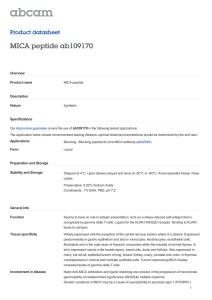
![Anti-MICA + MICB antibody [6D4] (FITC) ab46529 Product datasheet Overview Product name](http://s2.studylib.net/store/data/012444126_1-46a6a43c0e11a627c4734bdba66fd984-300x300.png)
